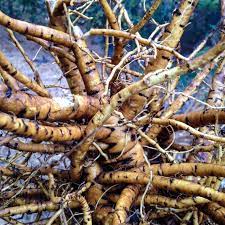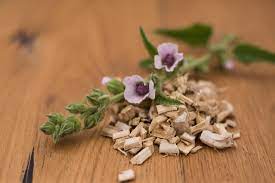Marshmallow Root
- Dave

- Mar 30, 2023
- 5 min read
Updated: Apr 8
Marshmallow Root

Botanical Name
Althaea officinalis
Common Name
Marshmallow root, marsh mallow, mallards, mauls, Schloss tea
Family
Malvaceae
Parts Used
root
Native To
Europe, western Asia, Africa
Harvesting Guidelines
The roots of the marshmallow plant are typically harvested in the fall after the plant has matured, generally after it has been growing for at least 2.5 to 3 years. The root contains the highest concentrations of the mucilage that provides its medicinal properties. When harvesting, wear gloves to avoid irritation from the plant's rough outer texture. The leaves of the marshmallow plant can be harvested throughout the summer, while they are still soft, fresh, and free from discoloration or mildew. After harvesting, dry the leaves and flowers in a shaded, well-ventilated area to preserve their active compounds.
Introduction
The marshmallow plant, known scientifically as Althaea officinalis, is a perennial herb native to Europe, Asia, and parts of North Africa. Best known today as the origin of the confectionery, marshmallow, the plant’s medicinal properties have been utilized for centuries. With its soft, velvety leaves and beautiful pale pink or white flowers, it is a gentle and nourishing herb that has earned a place in both traditional medicine and modern wellness practices. The mucilaginous root of the marshmallow is known for its soothing, anti-inflammatory, and demulcent properties, making it a valuable ally in treating various ailments, especially those affecting the digestive and respiratory systems.
Indigenous, Folk, and Traditional Uses
Marshmallow has a long history of use across various cultures. In Ancient Greece, the plant was prized for its healing properties, with Theophrastus mentioning its medicinal uses. The Romans consumed the root, while the Greeks ate the young aerial parts. In fact, the name "Althaea" comes from the Greek word for "to heal," reflecting its widespread reputation as a restorative herb. In medieval Europe, marshmallow root was commonly used to treat sore throats, coughs, and digestive problems.
Folk traditions also used marshmallow as a poultice for wounds and inflammatory conditions. Marshmallow’s cooling, moistening properties made it an ideal remedy for hot and sharp conditions, such as irritations in the gastrointestinal tract and respiratory system. It was considered a gentle, soothing herb capable of calming inflamed mucous membranes and soothing dry, irritated tissues.
Indigenous peoples, such as those in North America, have also used marshmallow for its healing qualities. Native American tribes used the root for treating a variety of ailments, including sore throats, stomach upsets, and skin irritation. The plant's ability to soothe and protect mucus membranes made it a vital component in herbal medicine.
Scientific Studies and Modern Research
Marshmallow root has been studied for its potent medicinal properties, especially its ability to support the healing of mucous membranes. The mucilage it contains forms a protective coating, which soothes inflamed or irritated tissues in the throat, digestive tract, and urinary system. The German Commission E, which evaluates the safety and efficacy of herbal remedies, has approved marshmallow root for treating irritation of the oral and pharyngeal mucosa, dry cough, and mild irritation of the gastric mucosa.
Recent studies also suggest that marshmallow's mucilage may have prebiotic effects, supporting healthy gut bacteria. Additionally, marshmallow root has been shown to have anti-inflammatory, diuretic, and emollient properties, making it a valuable herb for managing gastrointestinal disorders, urinary tract issues, and respiratory ailments. Some research also suggests that marshmallow’s soothing effects extend to the skin, where it can be used to calm irritation and promote healing.
Historical Background
The marshmallow plant’s medicinal properties have been recognized for thousands of years. Ancient Egyptian, Greek, and Roman civilizations used marshmallow root for a variety of health concerns. Theophrastus, an early Greek philosopher, mentioned marshmallow as a remedy for coughs, while Pliny the Elder touted it for its general health benefits. In the Middle Ages, marshmallow root was commonly used in European apothecaries, where it was considered a cure-all for respiratory issues, digestive complaints, and skin irritations.
By the 19th century, marshmallow’s roots were used to make a sweet treat that we now know as marshmallow candy, originally made by whipping the root’s mucilage with sugar. This confectionery treatment was distinct from the modern version, which is made with gelatin, but it demonstrates the versatility of the plant across both culinary and medicinal traditions.
Modern Uses
Today, marshmallow root is commonly used in herbal medicine for its ability to soothe sore throats, treat gastrointestinal discomfort, and support respiratory health. It is often used in teas, tinctures, and lozenges aimed at relieving coughs, dry throat, and inflammation of the digestive tract. Marshmallow is also added to creams and ointments for treating skin conditions like eczema, rashes, and minor burns due to its emollient and anti-inflammatory properties.
Marshmallow root’s mucilage is also used in modern herbalism as a gentle, non-irritating remedy for people with sensitive digestion. It is frequently recommended for conditions like gastritis, colitis, and irritable bowel syndrome (IBS). Additionally, marshmallow root can be found in supplements aimed at promoting general digestive health, soothing coughs, and alleviating urinary tract discomfort.
Adult Dose
Tincture: 1-4 mL of a 1:5 tincture, three times per day
Cold Infusion: 2-4 grams of dried root infused overnight in cold water, consumed as a beverage
Water Decoction: Simmer 1-2 teaspoons of dried marshmallow root in 1 cup of water for 10-15 minutes, and drink up to three times per day
Safety:
Marshmallow is generally considered safe for most individuals when used appropriately. However, due to its mucilaginous properties, it may inhibit the absorption of certain medications if taken at the same time. Therefore, it is advisable to space out marshmallow root consumption from pharmaceutical medications by at least 1-2 hours. Pregnant and breastfeeding women should consult a healthcare provider before using marshmallow, as there is limited research on its safety during these times.
Actions
Anti-inflammatory
Demulcent
Diuretic
Emollient
Expectorant
Energy
Cooling
Moistening
References:
Grieve, Maude. (1971). A Modern Herbal. Dover Publications.
Chevallier, Andrew. (2000). The Encyclopedia of Herbal Medicine. DK Publishing.
Ellingwood, Finley. (1919). The American Materia Medica, Therapeutics and Pharmacognosy.
Hoffman, David. (2003). Medical Herbalism. Healing Arts Press.
Pedersen, Mark. (2011). Nutritional Herbology. Whitman Publications.
Information offered on Achula and on this page is for educational purposes only. Achula makes neither medical claim, nor intends to diagnose or treat medical conditions. Women who are pregnant or nursing, and persons with known medical conditions, should consult their licensed healthcare provider before taking any herbal product. Links to external sites are for informational purposes only. Achula neither endorses them nor is in any way responsible for their content. Readers must do their own research concerning the safety and usage of any herbs or supplements.
tags:
Herbal medicine course
herbal school
wildpluk cursus
kruiden opleiding
geneeskrachtige planten
herborist
become a herbalist






